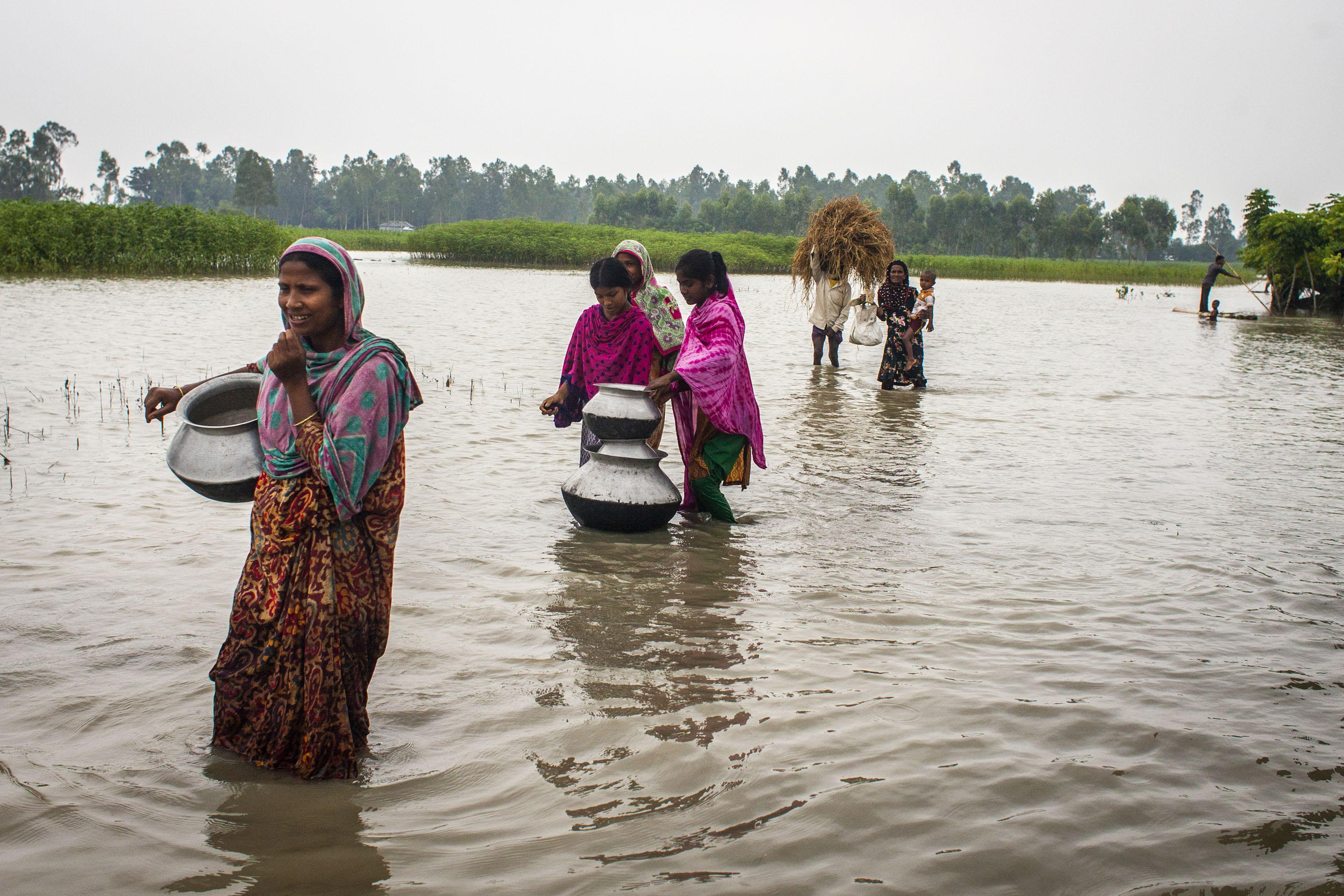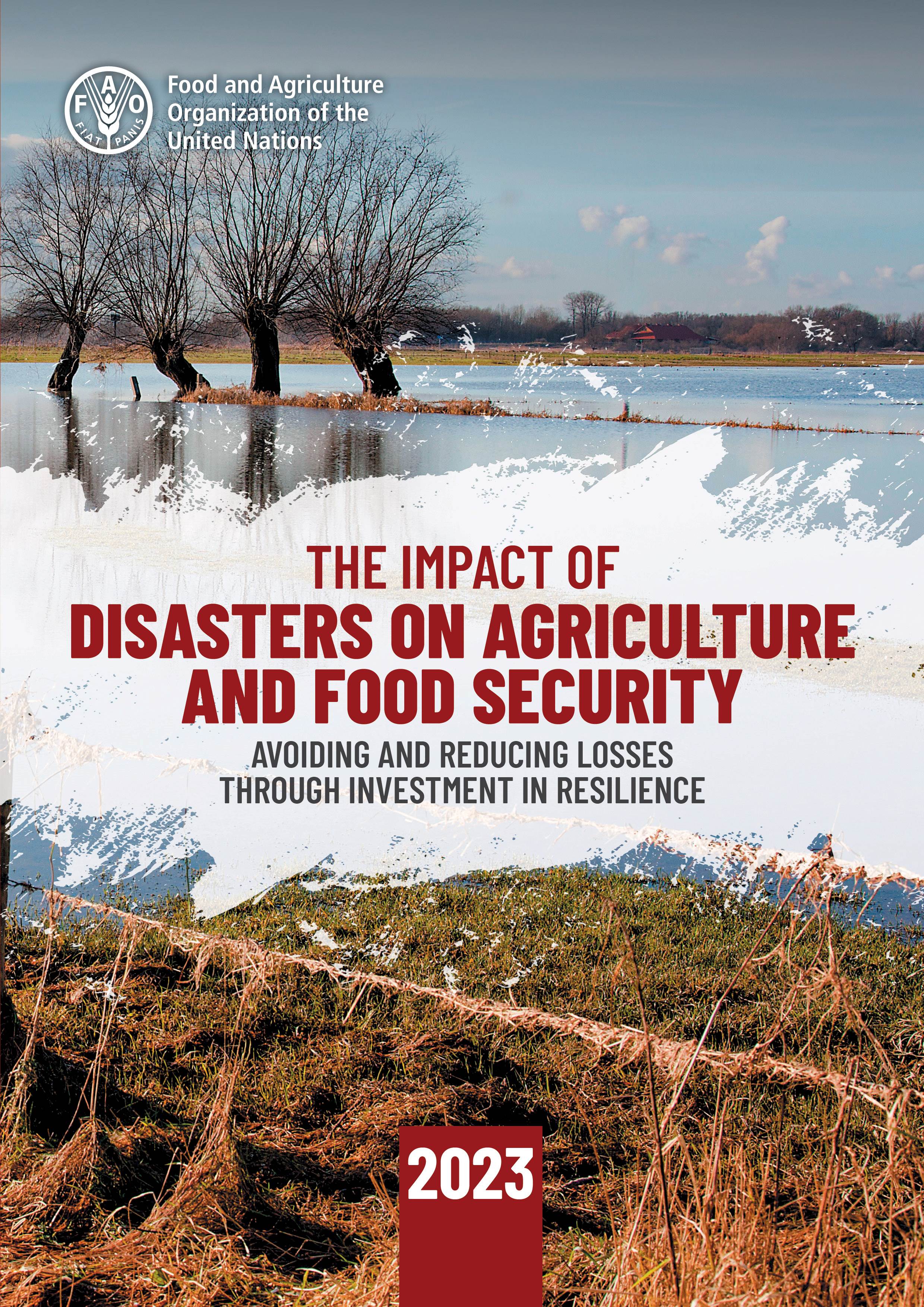First-ever global estimation of the impact of disasters on agriculture
New FAO report shows that about $3.8 trillion worth of crops and livestock production has been lost over the last 30 years

Flood victims head off to fetch drinking water using vases at Shakhahati village in Kurigram district, Bangladesh.
©FAO/Fahad Kaizer
Rome – Over the last 30 years, an estimated $3.8 trillion worth of crops and livestock production has been lost due to disaster events, corresponding to an average loss of $123 billion per year or 5 percent of annual global agricultural gross domestic product (GDP), according to a new report released today by the Food and Agriculture Organization of the United Nations (FAO).
A new FAO flagship report entitled “The impact of disasters on agriculture and food security” brings the first-ever global estimation of the impact of disasters on agricultural production focused on crops and livestock. It also notes that the figure may be higher if systematic data on losses in the fisheries and aquaculture and forestry subsectors were available. The report stresses the need for urgently improving data and information on the impact of disasters on all subsectors of agriculture to create data systems that can serve as the foundation upon which effective action can be built and informed.
“Agriculture is one of the most highly exposed and vulnerable sectors in the context of disaster risk, given its profound dependence on natural resources and climate conditions. Recurrent disasters have the potential to erode gains in food security and undermine the sustainability of agrifood systems,” said FAO Director-General QU Dongyu in the foreword to the report. “Leveraging FAO’s technical expertise, this publication showcases opportunities to proactively address risks in agrifood systems while demonstrating ways to mainstream disaster risk management into agricultural practices and policies.”
The report reveals that over the last three decades, disasters – defined as serious disruptions to the functioning of a community or society – inflicted the highest relative losses on lower and lower middle-income countries, up to 15 percent of their total agricultural GDP. Disasters also had a significant impact on Small Island Developing States (SIDS), causing them to lose nearly 7 percent of their agricultural GDP.
Losses by product groups
The report also indicates that losses related to major agricultural products are showing increasing trends. Thus, losses in cereals amounted to an average of 69 million tonnes per year in the last three decades – corresponding to the entire cereal production of France in 2021 - followed by fruits and vegetables and sugar crops, with each approaching average losses of 40 million tonnes per year. For fruits and vegetables, losses corresponded to the entire production of fruits and vegetables in Japan and Viet Nam in 2021.
Meats, dairy products and eggs showed an average estimated loss of 16 million tonnes per year, corresponding to the whole production of meats, dairy products and eggs in Mexico and India in 2021.
Regional differences
Global losses mask significant variability across regions, subregions and country groups. According to the report, Asia experienced by far the largest share of the total economic losses. Africa, Europe and the Americas also displayed a similar order of magnitude. However, losses in Asia only accounted for 4 percent of the agricultural added value, while in Africa they corresponded to nearly 8 percent. The variability was even higher across subregions.
In absolute terms, losses were higher in high-income countries, lower-middle-income countries and upper-middle-income countries, but low-income countries, and especially SIDS, suffered the highest incidence of losses in agricultural added value.
Cascading impacts of disasters
Disaster events have increased from 100 per year in the 1970s to around 400 events per year worldwide in the past 20 years. Not only are disaster events increasing in frequency, intensity and complexity but their impact is also expected to worsen, as climate-induced disasters amplify existing social and ecological vulnerabilities.
The report highlights that, when hazards manifest, they can produce cascading impacts across multiple systems and sectors. Underlying disaster risk drivers include climate change, poverty and inequality, population growth, health emergencies caused by pandemics, practices such as unsustainable land use and management, armed conflicts and environmental degradation.
The amount of loss and damage produced by a disaster depends on the speed and spatial scale at which a hazard interacts with vulnerability and other preexisting risk factors, along with the amount of exposed assets or livelihoods.
In extreme cases, disasters result in the displacement and outward migration of rural populations. Massive flooding triggered by abnormal monsoon rains in Pakistan’s southern province of Sindh is an illustrative example of how the combination of slow and sudden onset hazards triggered displacement, negatively impacting agrifood systems and increasing food insecurity.
Towards greater resilience of agrifood systems
Farmers, particularly smallholders farming under rain-fed conditions, are the most vulnerable actors in the agrifood systems and bear the brunt of disaster impacts. Supporting the adoption of farm-level disaster risk reduction good practices can help small-scale farmers to avoid losses and enhance their resilience. Investment in farm-level disaster risk reduction good practices can perform on average 2.2 times better than previously applied practices.
Proactive and timely interventions in response to forecasted hazards are crucial to build resilience by preventing and reducing risks in agriculture. For instance, anticipatory action undertaken in several countries demonstrated favourable benefit to cost ratios for investing in disaster prevention and resilience. The report shows that, for every $1 invested in anticipatory action, rural families can gain up to $7 in benefits and avoided agricultural losses.
The report outlines three key priorities for action: improving data and information on the impacts of disasters on all subsectors of agriculture – crops, livestock, fisheries and aquaculture, and forestry; developing and mainstreaming multisectoral and multi-hazard disaster risk reduction approaches into policy and programming at all levels; and enhancing investments in resilience that provide benefits in reducing disaster risk in agriculture and improve agricultural production and livelihoods.
- Video interview with FAO Chief Economist Maximo Torero on the impacts of disasters on agriculture
- B-Roll: Impact of Disasters on Agriculture and Food Security
- In Brief: The Impact of Disasters on Agriculture and Food Security
- FAO: Statistics
- FAO: Food and Agriculture Statistics
- FAO in Emergencies and Resilience
- A methodology for estimating disaster-induced crop and livestock losses at the global scale
- Impact of the drought on Somali livestock keepers
- Fall armyworm: measuring damage and loss caused by a novel invasive pest as a guide to sustainable management
Contact
Irina Utkina FAO News and Media (Rome) +39657052542 [email protected]
FAO News and Media (+39) 06 570 53625 [email protected]

